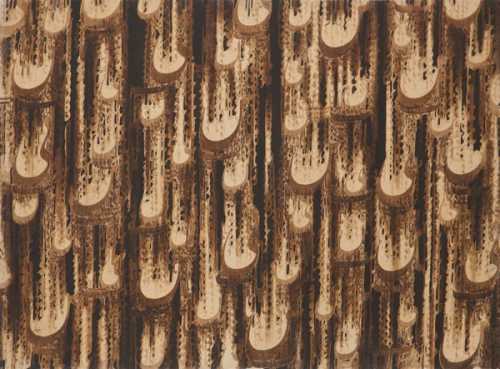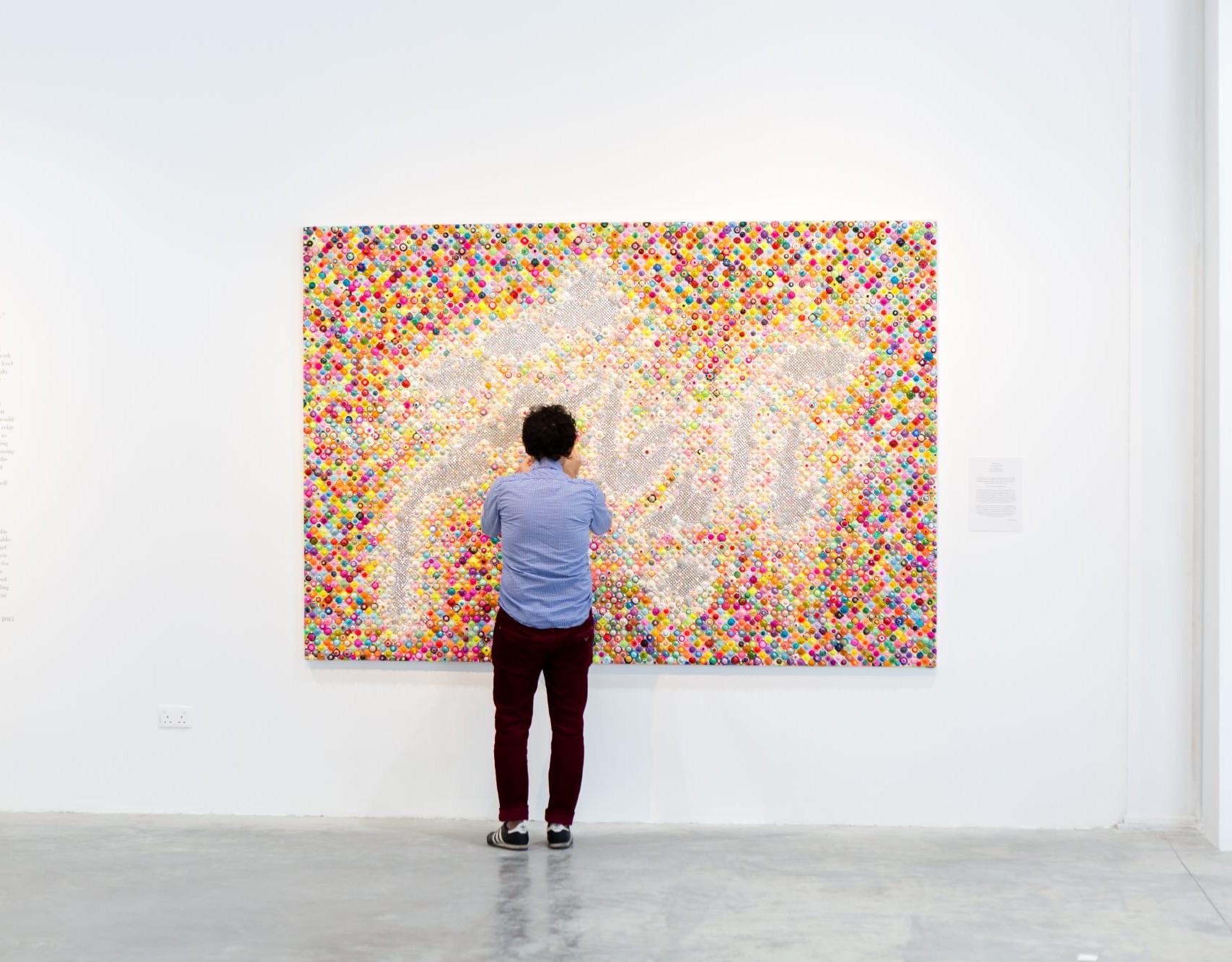About Reza Mafi
Reza Mafi is considered one of the neo-traditionalist artists and one of the pioneers of the calligraphic painting movement. His passion for art matured in him from childhood, next to an older brother who had a hand in visual arts and a father who was an engraver and goldsmith. From childhood, he started learning calligraphy from one of Mashhad's most famous calligraphers, Jalaloddin Etezadi. Working in the market and embroidery experience also impacted the formation of his artistic mentality and familiarity with decorative motifs.
Mafi was eighteen years old when he decided to go to Tehran. After three years of scattered activities in calligraphy and painting, he entered the Iranian Calligraphers Association and studied calligraphy under Hossein Mirkhani's supervision. After completing this training course, he devoted himself to calligraphy and focused on the calligraphy of Mirzarza Gholamhossein Esfahani, one of the calligraphers of the Qajar era; This experience left a profound impact on the mood of his writings. During this period, Sagha Khaneh and neo-traditionalism were new to the art community of Tehran, and Mafi was also involved in this current. He was one of the first calligraphers who tried to combine calligraphy with painting and exhibited his trial and error for the first time in the Seyhoun Gallery, which caused a stir in the art scene of that time. His skill and interest inspire his calligraphic paintings in Nastaliq calligraphy. His familiarity with Persian literature was also reflected in the poems and text selection and was one of his artwork's strengths. Inspired by the plasterwork of mosques and their connection with calligraphy, he started to create famous 3D paintings. By using materials such as Styrofoam and combining it with glazing techniques, he pushed modern calligraphy towards dimensional experiences. Although he was considered a progressive and experimental artist working with different materials, he tried to remain faithful to the traditional mood of calligraphy in aspects such as the selection of colors. He avoided using bright and unfamiliar colors and preferred brown shades. Ochre, dark green, etc., was enough. In the description of Mafi's working methods, Pakbaz writes: "In 1967, he started his work in this field with colorful black Siah Mashgh. After a while, it turned into a toghraei. In his latest artworks, he mainly used Sohrab Sepehari's compositions for the painterly use of Nastaliq and broken Nastaliq styles. In 1967, Mafi exhibited his artworks for the first time in a collective exhibition at the National Museum of Iran. He presented his paintings in numerous exhibitions in Iran and abroad, including the Islamic Art Festival in 1976 London. His artworks have been exhibited in Paris, Switzerland, and Bologna, Italy.
Reza Mafi's first appearance in auctions goes back to March 2008 at Bonhams auction house. Until February 2022, his artworks have appeared 39 times in domestic and foreign auctions, and 66% of his artworks have been sold in international auctions. His most expensive work until 2021 was hammered at Christie's auction house for $217,000 on May 11, 2017.
The Most Expensive Artwork
At Auctions
First Attendance
3 March 2008
# Attendance
37
# Artworks
47
Average Realized Price
53,294 USD
Average Min Estimate
33,328 USD
Average Max Estimate
46,149 USD
Sell-through Rate
70.213%
Average Growth of Artwork Worth
26.395%
Timeline
The 23rd Tehran - Modern and Contemporary Iranian Art auction
22 May
The 22nd Tehran - Modern, Classic and Traditional Iranian Art auction
14 February
Timeless Creation exhibition
25 October
The 21st Tehran - Contemporary Iranian Art auction
11 October
The Pioneers of Modern Iranian Art Vol.3 exhibition
24 August
Golden Years exhibition
14 June
The Artwork of Legendary Artists exhibition
9 February
The 19th Tehran -Classic and Modern Iranian Art auction
24 January
Modern Collectore exhibition
19 January
Antiquities, Islamic and Indian Arts auction
28 April
Antiquities, Islamic & Indian Arts auction
1 April
Middle Eastern Art Online Sale auction
9 February
International Art auction
7 May
Collector 7 exhibition
5 February
The 13th Tehran- Modern and Contemporary Iranian Art auction
15 January
Modern and Contemporary Middle Eastern Art auction
24 November
No.6 auction
16 October
Calligraphy auction
16 July
One by One exhibition
3 July
یازدهمین دوره حراج تهران auction
5 July
Abstract and Contemporary Art auction
12 December
The 9th Tehran- Classic and Modern Iranian Art auction
29 June
Shams gallery Collection Special Sale exhibition
7 July
هفتمین دوره حراج تهران auction
7 July
Remembrance of Master Reza Mafi exhibition
18 May
Modern & Contemporary Art auction
18 October
Group exhibition exhibition
30 September
پنجمین دوره حراج تهران auction
27 May
The Art of Lebanon and Modern and Contemporary Middle Eastern Art auction
27 April
چهارمین دوره حراج تهران auction
29 May
Islamic and Indian Art auction
7 October
سومین دوره حراج تهران auction
30 May
Islamic and Indian Art auction
8 April
Modern & Contemporary Arab, Iranian & Turkish Art auction
19 March
دومین دوره حراج تهران auction
28 May
اولین دوره حراج تهران auction
22 May
Modern and Contemporary Arab, Iranian and Turkish Art Part I auction
25 October
Modern and Contemporary Arab, Iranian and Turkish Art auction
19 April
Hurouf: The Art of the Word auction
16 December
Drouot Richelieu, Salle 7, Vente Tableaux Modernes auction
19 November
International Modern and Contemporary Art auction
26 October
Modern & Contemporary Arab, Iranian, Indian & Pakistani Art auction
24 November
International Modern and Contemporary Art auction
30 October
Modern and Contemporary Arab and Iranian Art auction
23 October
International Modern and Contemporary Art auction
30 April
Modern & Contemporary Arab, Iranian, Indian & Pakistani Art auction
3 March
Articles
Market of Iranian Neo-calligraphers 15 August 2023
Neo-calligraphic style entered the modern Iranian art movement in 1964 with the efforts of the pioneers of the Saqakhaneh movement, namely Hossein Zenderoodi, Parviz Tanavoli and Faramarz Pilaram. From this movement, later, a trend called Calligraphy-Painting branched out, which, to some extent, adhered to the rules and style of traditional calligraphy. Since the the 2000s, with the...
Iran's Art in London's Islamic Art Week, An Overview 6 May 2023
London Islamic Art Week is an event that is held two to three times a year; Every spring and autumn, Sotheby's, Christie's, Bonham's, Chiswick and Rosebery's Islamic artauctions are held in different cathegories by the Islamic and Indian Art departments. These auctions include art works of the Islamic world from the middle of the 7th to the 20th centuries, and among them are works f...


